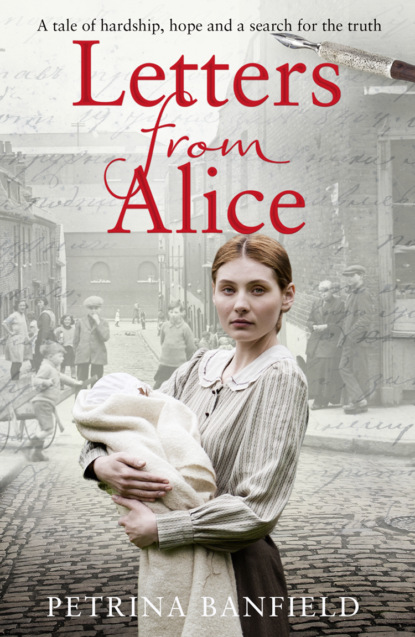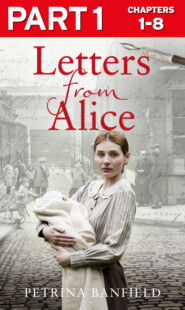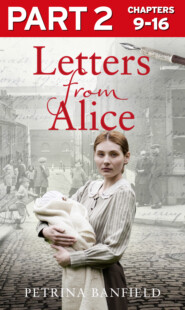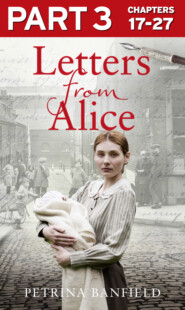По всем вопросам обращайтесь на: info@litportal.ru
(©) 2003-2024.
✖
Letters from Alice: A tale of hardship and hope. A search for the truth.
Настройки чтения
Размер шрифта
Высота строк
Поля
Chapter Nineteen (#litres_trial_promo)
Chapter Twenty (#litres_trial_promo)
Chapter Twenty-One (#litres_trial_promo)
Chapter Twenty-Two (#litres_trial_promo)
Chapter Twenty-Three (#litres_trial_promo)
Chapter Twenty-Four (#litres_trial_promo)
Chapter Twenty-Five (#litres_trial_promo)
Chapter Twenty-Six (#litres_trial_promo)
Chapter Twenty-Seven (#litres_trial_promo)
References (#litres_trial_promo)
Acknowledgements (#litres_trial_promo)
About the Publisher (#litres_trial_promo)
Note to Reader (#u71057930-510a-59d4-be5f-83948873ab46)
I was thirteen years old when I first discovered that my father spent his childhood in care. Until then he had never spoken to me about his past and, as children are so adept at doing, I somehow picked up that it was a subject to be tiptoed around, without ever having been told. The truth came out one Sunday afternoon after I plucked up the courage to ask for the names of my paternal grandparents, so that I could complete a genealogy project for school.
Perhaps he felt I’d reached an age of understanding because after a moment’s hesitation he told me that he knew very little about his parents, who had died long before I was born. Even this snippet of information was fascinating to me and I listened eagerly as he told me about the grandmother I’d never met – a petite Irish woman who had experienced too much pain and not enough love. By the age of twenty-five she had given birth to five children.
The shadow cast by childhood trauma stretched far into the future though, and in 1941 three of her children were taken into care, including my father and his twin brother – the youngest, at six months old.
Ever since hearing my father’s story I’ve been captivated by the idea of the corporate parent; society waiting with a safety net to cradle those most in need. For as long as I can remember, I’ve wanted to be part of that narrative. I finally applied to become a foster carer in 2006.
On my initial ‘Skills to Foster’ training course, the tutor told us that three fates awaited unwanted children of the distant past: death by exposure, prostitution or Christian adoption. We learned that homeless children and orphans in Britain were first ‘boarded out’ with foster carers in the latter part of the nineteenth century and that hospital almoners were the forerunners of modern social workers. But it was only in 2014, in trying to reassemble the scattered fragments of my father’s childhood puzzle, that I learned more about the almoners’ remarkable work.
I knew that Dad suffered with severe eczema as a child (he was separated from his twin at the age of five, his weeping wounds perhaps a physical manifestation of his sense of loss) and spent prolonged periods of time in hospital in London at some time during the Second World War, so I visited the London Metropolitan Archives (LMA) and began my search there.
Not really knowing where to start, I put in a request for old files from the Royal Free Hospital and its associated hostels in London. Within half an hour, several boxes had arrived in the reading room. Excitedly, I started going through the first one and, beneath the envelopes filled with receipts and manila files tied up with string, I found a smaller box containing almoners’ reports from the 1920s.
As I worked my way through the dusty papers I read about girls ‘very young, not more than sixteen or seventeen years old’, who had ‘fallen into trouble’ as a result of living in conditions that were ‘past belief … involving very grave and unusual risks of infection’. As well as being pregnant, homeless and ‘turned adrift’ by their families, some of the poor girls were in agony as a result of a double infection of syphilis and gonorrhoea.
One almoner recorded that one of her patients, a girl suffering from gonorrhoea, was ‘one of six siblings who all slept in one bed, in a room like a cupboard, with no outer air’. Another young girl ‘lived over a stable with no access except by a ladder-like stair’.
On arrival at hospital many were ‘in a state of nervous and physical exhaustion, and of resentment requiring great tact and care in dealing with them. Some [were] put to bed, till the irritable condition of their nerves [was] soothed, and many of them [slept] for days … some descend[ing] to the depths of despair [,] bringing them to the verge of insanity’.
As I leafed through the file of fragile papers, a small bundle of handwritten letters written by one of the almoners – here, I will refer to her as Alice – fell out from between the pages. Beautifully written in a gently sloping script of fading black ink, and without a trace of the toxic condemnation that awaited the girls in society at large, they showed the almoner reaching out to her contacts in the community in search of ‘well-disposed people’ who might find it in their hearts to take them in.
A picture of Alice began to emerge: a fiercely intelligent woman from a sheltered background, filled with a sense of purpose and unafraid to challenge the conventions of the day. In Letters From Alice, Alice’s character, her attitudes and motivations are drawn from the common experiences of women of her time and social station; she belongs to a generation of women emboldened by the progress of the Suffragette movement and ready to make their voices heard. Striding around some of the poorest parts of London in her ankle-length skirts, I imagined Alice immersed in a world of complex social problems, ones that resonate strongly with me as a foster carer today: homelessness and deprivation, incarceration, domestic violence, intoxication from opium and alcohol, and, inevitably, the neglect and deliberate abuse of children.
What follows is a retelling of the experiences of one of the girls (I will call her Charlotte) through the eyes of Alice, using the letters, almoners’ reports and case files from the LMA as inspiration. Quotes have been lifted directly from the archive material, unless otherwise stated. Weather reports have been sourced from the Meteorological Office. Where the records are scant or incomplete, I have drawn on my research of the morals and expectations of society through the 1920s and my own imagination, to inject character into the disembodied voices in the reports and bring the stories to life on the page.
Prologue (#u71057930-510a-59d4-be5f-83948873ab46)
Unlike doctors and nurses [the almoner] is a newcomer in the hospital world, but she finds all the benefits of its traditions at her disposal. Whether the almoner is there or not, a tapestry is being woven by the work of the hospital, but it may be an incomplete piece of work and apt to unravel if she does not play her part in gathering up and connecting the broken threads.
(The Hospital Almoner: A Brief Study of Hospital Social Science in Great Britain, 1910)
It was a little before seven o’clock in the evening on 17 April 1921 when twenty-eight-year-old almoner Alice Hudson summoned the police constable for help.
PC Hardwicke’s heavy boots tramped over the icy pavements in the east London district of Bow, Alice leading the way a few steps ahead. The weather during early April had been milder than usual, but over the last few days the temperature had plummeted, a depression from Iceland bringing gales over the eastern coasts and snow showers to the capital.
Daylight was beginning to fade as they reached their destination: a two-storey boarding house flanked by a derelict pub and a paper merchants. Alice had stopped by to see Molly Rainham half an hour earlier through concern for the young mother’s welfare, she later reported to the coroner. Despite knocking for several minutes and tapping on the frosted window pane, the only response had been an unidentifiable, plaintive bleat in the distance.
Hospital almoners were accustomed to a variety of reactions to their unannounced visits, but there was something strange about the silence echoing around the hall on the other side of Molly’s front door; a ghostly stillness that had sent Alice hurrying to the local police station.
From the notes in the almoner’s file back at the Royal Free Hospital, Alice knew that Molly may have been suffering from post-natal psychosis. According to reports she had initially coped well with motherhood, but seemingly overnight her demeanour had changed. With her husband on a military posting in Constantinople and no other family to speak of, Alice made a point of calling in on her patient whenever her schedule allowed.
‘We need to break in,’ the almoner insisted, as PC Hardwicke rapped again on the front door.
He was still tapping half a minute later as Alice scrabbled at the downstairs window and wrenched it upwards. Before the PC managed to reach the almoner, his long-tailed dark blue coat flapping behind him, she had already bunched the damp hem of her long skirt up in one hand and was clutching at the window frame with the other. In one motion she crawled forwards and hauled herself over the sill, the bobby pivoting on his heels and averting his eyes behind her.
A hundred yards to the east, the bells of St Mary le Bow boomed the hour. As the policeman followed Alice through the window, a seagull cried out mournfully in the darkening sky above, a reminder to the onlookers that had begun to gather outside the small property of their proximity to the docks and the wide sea beyond.
The passageway was dark. Perhaps to soften the impact of a sudden intrusion, Alice and the PC slowed when they reached the top of the stairs, then exchanged glances. Besides an unpleasant smell, there was an undertone of something else in the air, something disturbing. With a grim expression, the bobby turned towards the master bedroom at the front of the house.
A few steps later he faltered, stopping so abruptly that Alice almost walked into the back of him. The groan that escaped him should have offered some warning of the scene awaiting her, but when Alice stepped forwards she gasped in horror. Inside the room on a bloodstained mattress, Molly was stretched out on her back, her eyes and mouth gaping. The sinews in her neck were taut, her powdered cheeks etched with the chalky deposits of dried-up tears.
It was Alice who reached the bed first. The emergency drills she had learned as a Voluntary Aid Detachment (VAD) nurse assessing casualties during the war years came back to her instantly. She ran her eyes over Molly, methodically checking for vital signs. Half a second later, she turned to the constable, gave a grim shake of her head then hurried past him into the hall.
The door to the small bedroom at the back of the house stood open. Alice hesitated in the doorway for a brief moment, then ran over to the cot by the window, where Molly’s infant son lay. Bracing herself, she leaned over to feel the skin at the back of his neck. Her legs buckled then – it was warm to the touch. Had she been half an hour earlier in rousing the alarm, the deputy coroner for east London later reported to the inquest held in Stepney, the baby boy might have been saved.
The death of Molly and her son was the first in a series of shocking cases that Alice Hudson became involved in, one that marked a turning point in her career, redefining the way she viewed herself and the world around her. When Alice returned to the Royal Free Hospital on Gray’s Inn Road and wrote up her report of the incident, she was unaware of the tangled threads that tied Molly to a case that rocked her above all others: the web of deception that began to unravel months later, on New Year’s Eve, 1921.
Chapter One (#u71057930-510a-59d4-be5f-83948873ab46)
The question of the abuse of voluntary hospitals is one of wide knowledge. It has led to the creation of the hospital almoner, and there is a great future in front of her … Students should be between the ages of twenty-five and thirty-five, and the more knowledge of the world and of general interests that they can bring to their training, which lasts at least eighteen months, the better.
(Pall Mall Gazette, 1915)
By the middle of the afternoon on 31 December 1921, Alice Hudson had ticked off almost all of the duties on her weekend list.
It was three degrees Celsius, the sort of weather that prescribed hot drinks and thick blankets, and the almoner might have spent the day huddled in front of the log fire in the nurses’ home instead of trudging across the icy streets of east London, had it not been for the pile of urgent home visits weighing down the desk of her basement office.
Although December 1921 had been generally mild, Londoners shouldered frequent high winds and gales towards the end of the month. Today, Saturday, there was a cloud of sulphur in the air, the sky stretching over the Thames as grey as the sediment lurking at its depths. Conditions were likely to worsen over the next few hours but, all being well, Alice would be back in her room before dark.
The signs were promising. It was 2.30 p.m. and she was already three calls down, with only one to go.
The almoner took hurried, lopsided steps along the pavement overlooking the river, a briefcase full of patient files bumping against her ankle-length cape. In the distance, the faint blue glow from the lamplighter’s pole twinkled reflectively over the surface of the Thames as he worked his way, much earlier than usual, along Tower Bridge. Several children had walked unwittingly through the vapours into the frozen waters during the last terrible smog. The flickering lights glinting over the water offered at least some degree of reassurance for pedestrians.








